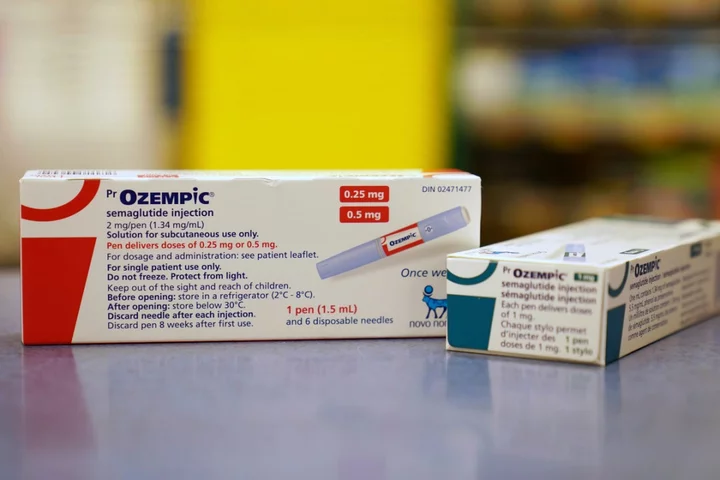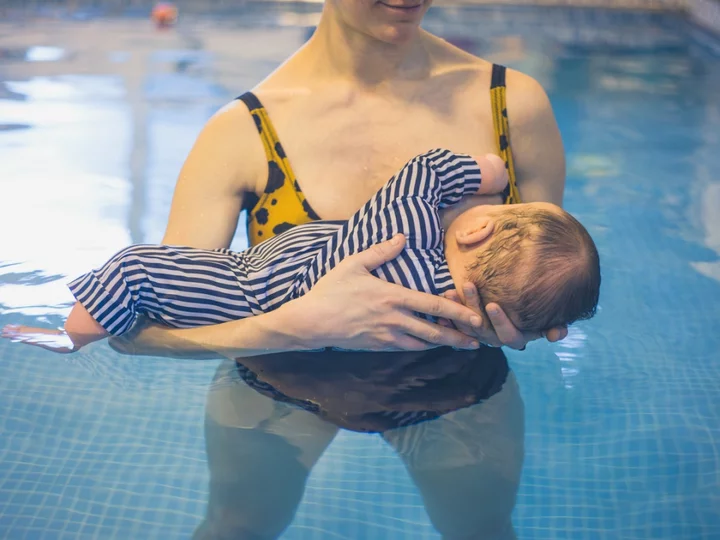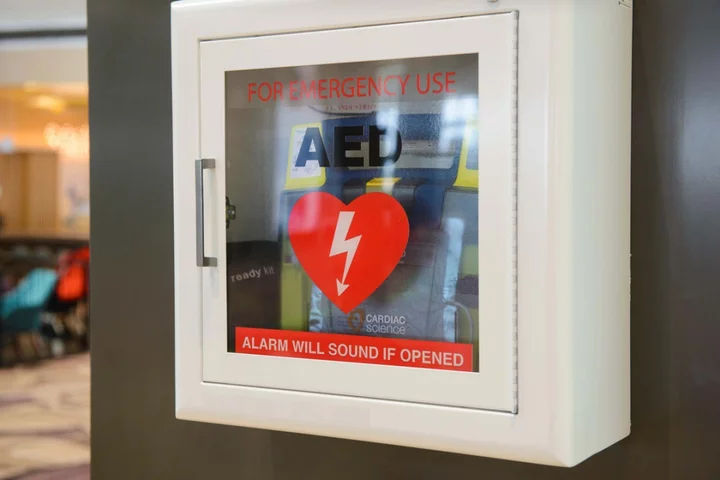
One-pot roast chicken with chorizo, garlic and rosemary
There is nothing more comforting than a roast chicken – a go-to every week and something my family are always happy to see,” says chef Emily Scott. “The chorizo, lemon and rosemary create a wonderful gravy of buttery golden juices; with the potatoes and garlic, it really is a delicious one-pot recipe.” Roast chicken with chorizo, garlic and rosemary Serves: 4 Ingredients: 1 whole properly free-range chicken (about 1.5kg/3lb 5 oz) 50-100g (2-3½oz) unsalted butter, softened 6 rashers of unsmoked streaky bacon 2 lemons, halved 8 rosemary sprigs 12 garlic cloves, left whole and unpeeled 2 tbsp olive oil 300g (10 ½oz) chorizo, thickly sliced 500g (1lb 2oz) small new potatoes, left whole Cornish sea salt and freshly ground black pepper Method: 1. Preheat the oven to 200C (180C fan/400F/gas 6). Place the chicken in an oven-to-table roasting dish. Rub the breasts and legs with the butter, season with sea salt and freshly ground black pepper, then place the streaky bacon over the breasts of the chicken (this protects the breast meat for the first part of the cooking, keeping the meat moist and adding delicious flavour. The crispy bacon becomes the cook’s perk). 2. Place the lemon halves and most of the rosemary in the cavity. Arrange the garlic cloves around the chicken in the oven dish, then drizzle the whole chicken with the olive oil. Roast in the oven for 15-20 minutes until the bacon is crispy. 3. Remove the dish from the oven, remove the bacon and set aside. Baste the chicken with the buttery and lemony juices, then arrange the slices of chorizo and small potatoes around the chicken with the remaining rosemary sprigs. Return to the oven to roast for 45 minutes–1 hour until the chicken is golden brown and the juices run clear (test by inserting a skewer into a leg). 4. Remove from the oven and allow to rest for 10 minutes. Carve and serve with the buttery, golden juices, with the roasted potatoes and chorizo, accompanied by greens or a green salad. ‘Time & Tide’ by Emily Scott (Hardie Grant, £28).
2023-07-26 13:58

Husband fired from family business after wife roleplayed with reborn dolls
A woman who turned to roleplaying with hyper-realistic dolls “to help (her) cope” with the death of her first baby – and continues to do so with her husband and two rainbow babies – has said her husband’s parents disapproved of the hobby and fired him from the family business as a result. Christina Keeler, 38, a stay-at-home mum and YouTuber, from Wyalusing, Pennsylvania, USA, fell pregnant with her first “miracle” baby in 2015, despite having endometriosis and being told she would not be able to conceive in her 20s. She suffered a miscarriage, but after watching a documentary about so-called reborn dolls, she had a “lightbulb moment” and realised getting a hyper-realistic doll would be the “perfect solution”. Christina’s husband Bill, 43, was “hesitant” at first but became supportive after he saw how much it “helped (her) grief”. The couple went on to have two “miracle” daughters, Grace, six, and Joy, four, who now help feed, change and dress the family’s five reborn dolls – which cost between £1,560 and £3,899 each – in their “nursery” complete with “a crib and a wardrobe”. The family often take the dolls out in public, and have shared their journey on YouTube – where Christina documents people’s reactions to her dolls and birthing videos. Some silicone dolls come in a fake womb which allows a Caesarean section to be performed at home. But Bill’s family were “disgusted” with the hobby, to the point where they gave him a choice to stop having the dolls or leave the family business. He refused to shut down the YouTube channel and did not want Christina to give up her hobby, so he was fired. She fell pregnant with her first baby in 2015, a year after her mother died of cancer. The couple were “elated” about the pregnancy because Christina had been told in her twenties that she would not be able to conceive because she has endometriosis, but she miscarried at eight weeks. Christina told PA Real Life: “When we lost the baby it was so devastating, I remember lying in the hospital bed after they had taken the baby out of my belly, and screaming for my mum and wept wanting to cuddle my baby.” She “really struggled” with the grief of losing her mother and her baby so close together. She explained: “This feeling of sorrow just never went away, it was so painful that I never talked about it again.” Despite having her two “miracle” children Grace and Joy, Christina still longed to hold her first baby, and after watching a documentary about reborn dolls, she wanted to get one to see if it would help her grief. She said: “I felt so blessed to have two healthy girls, but that feeling of missing the first baby never quite went away. “When my youngest was around two years old, my husband and I came across a documentary about reborn dolls. “And he was like, ‘That’s really weird’, and I played it off that I thought the same, but actually I really wanted one to help me cope and I thought it would be the perfect solution.” After persuading her husband, Christina ordered her first lifelike doll, Hannah, costing her around £155. She said: “I told my husband and he was not on board at all, he was hesitant, but after explaining my reasoning, he was much more understanding and more accepting.” When the doll arrived, Christina instantly felt like it helped with her mourning. She said: “It helped me therapeutically because for the first time ever when I got my first reborn doll, I was able to talk about the loss of our baby. “And since then I have healed tremendously from that loss because I’m able to talk about it and share my story and help others – it helped my grief, for sure.” Christina now has a collection of five dolls called Carter, Cadence, Quinn, Isabella and Sammy, which she loves to dress, cuddle and feed. She takes the dolls out in public and people often mistake them for real babies. She said: “We have a nursery for them with a crib and a wardrobe. I check on them throughout the day, and on other days, especially when the girls want to get involved, I pick out an outfit for them, bring them to breakfast, get them to feed them a bottle, change them. “If we’re running errands we often take them out with us and put them in a car seat and stroller.” Christina and her family have been sharing their experiences on YouTube, where they are known as The Reborn Family. She said: “I make videos about people’s reactions to my dolls, as well as vlogs and birthing videos – I have some silicone reborn dolls which come in a womb and you perform a C-section on it at home, to give birth to the baby.” Despite her immediate family being supportive of the hobby, Christina admits not everyone in her wider family understands. She said: “My husband’s family were, and still are, disapproving of the reborns, even though they can see how much they helped me. They were disgusted. “We moved from California to Pennsylvania because my husband was next in line to take over the family business because they were about to retire, and they asked if we would like to do so and we agreed. “When they were on vacation they came across our YouTube channel, and they called us up and they were mortified and so embarrassed, and said we were ruining the family name.” When Bill’s parents came home, they gave him an ultimatum to stop having the dolls. Christina explained: “Bill said that he was not going to quit his job, and didn’t want me to stop having reborns because they were so therapeutic for me at the time, and his dad said, ‘Well, then you’re fired’.” My husband’s family were disgusted, they said we were ruining the family name Bill’s father was contacted by PA Real Life for comment, but he had not responded at the time of publication. Even though her reborns have caused tension in the family, Christina cannot see herself giving up her hobby any time soon. She said: “Reborns continue to help me with my grief, and I love sharing content with other people who have lost babies, and they can also really help people with dementia, people who are infertile, people with anxiety and depression, I wouldn’t want to stop this.” Read More Teenager who thought she was pregnant diagnosed with ovarian cancer Woman praised for response to parents who asked her to swap first class seat with their child Barbie vs Oppenheimer: Greta Gerwig makes history with biggest box office opening for a female director
2023-07-26 13:57

Simple, versatile, delicious: Blackberry and peach crumble
This recipe is so simple and versatile – I use it to top fruit throughout the seasons,” says chef Emily Scott. “It is lighter than a traditional oat crumble topping, and delicious served with custard or crème fraîche.” Blackberry and peach crisp Serves: 4 Ingredients: For the Amaretti crumble topping: 160g (5½oz) amaretti biscuits 80g (3oz/scant 1 cup) flaked (slivered) almonds 75g (2½oz) unsalted butter, at room temperature 50g (2oz/scant ½ cup) plain (all-purpose) flour 50g (2oz/scant ¼ cup) caster (superfine) sugar For the bramble and peach filling: 350g (12oz) blackberries 6 peaches, skinned and stoned (pitted), sliced (if using frozen peaches, thaw and drain first) 100g (3½oz/scant ½ cup) caster (superfine) sugar 3 tbsp cornflour (corn starch) slaked with 2 tbsp water Zest and juice of ½ lemon Method: 1. Preheat the oven to 200C (180C fan/400F/gas 6). For the crumble topping, blitz the amaretti biscuits with the flaked almonds in a food processor to a rubble. 2. In a mixing bowl, rub the butter and flour together to resemble breadcrumbs, then add the sugar along with the almond rubble and mix together. 3. Spread the mixture out over a baking sheet and bake in the oven for 10-15 minutes until golden. Allow to cool. 4. For the filling, place the blackberries, peaches, sugar, cornflour mixture, lemon zest and juice in a heavy-based saucepan and slowly bring to a simmer, stirring all the time to allow the sugar to dissolve. Cook until the fruit is tender. 5. Transfer to an oven-to-table baking dish and sprinkle over the amaretti crumble topping. Finish off in the oven for 5–6 minutes. Don’t forget the cream. ‘Time & Tide’ by Emily Scott (Hardie Grant, £28).
2023-07-26 13:52

Emily Scott: ‘It’s quite normal for people with eating disorders to end up working in food’
Emily Scott has called the UK’s southernmost county home for 25 years, but the chef’s roots in the region go back even further. “I spent a lot of time in Cornwall as a child, because my grandparents had a house down here,” says Scott, 48, on a video call from her home near Newquay. “And also in France, because my grandfather was half-French and they lived out in Provence.” Born in Sussex, she moved to the picturesque village of Port Isaac aged 23 and married her first husband, a fisherman, and the couple had three children, Oscar, 21, Finn, 20, and Evie, 18. “Sadly, I divorced the fisherman – or not sadly, I’m not sure – but actually, it’s all very amicable. “But I chose to stay in Cornwall… and my career has just grown and got better and better.” Scott’s first foray into food was the seaside Harbour Restaurant in Port Isaac, followed by eight years running the much-loved St Tudy Inn gastropub and rooms. Now, she’s creative director (“I’m not apron-on as much as I used to be”) at Emily Scott Food, the restaurant that sits on the sea wall at Watergate Bay. What unites all these culinary outposts? “I’ve been banging the simplicity drum for a long time – my food’s all about seasonality, but also not too much faffing around.” That ethos is evident in her second cookbook, Time & Tide, which includes plenty of one-pot main dishes, simple suppers and satisfying bakes. “It’s about times of day,” says Scott, who lives with her partner Mark Hellyar, a winemaker, and her children. “There’s a lovely chapter called ‘morning cafe’ with lots of nods to my French roots, because that’s just a very natural thing for me. We’ve got ‘rise and shine’, meaning breakfast time, we’ve got ‘seaside soirees’.” The recipes reflect Scott’s trademark Cornish-French fusion with seafood – scallops, mussels, mackerel, crab – taking centre stage alongside French culinary classics like beurre blanc, bouillabaisse, ratatouille and creme brulee, while Cornish sea salt and clotted cream appear on many an ingredients list. The book cover features a quote from American actor and foodie Stanley Tucci, who has become a friend. “It’s just been a very natural coming together through food,” says Scott. “You know, when you see him on television in his Italy series, he genuinely is that person. He genuinely loves food and wine, and that’s what connects everyone in my view.” The chef and author didn’t always have such a favourable view of feasting. She had anorexia in her teens and was forced to drop out of school. After going in and out of treatment, she was offered the opportunity to go and work in a hotel restaurant in France. “It’s quite a normal thing for people with eating disorders to end up in food, I think, because, I mean, you can’t give up food,” Scott says. “I just ended up – kind of through choice – just recovering, and turning my rather unhealthy relationship with food around, and finding the joy of cooking for people.” In 2021, the restauranteur got the chance to cook for some very important people when she was asked by the Cabinet Office to cater a dinner for world leaders at the G7 summit in Cornwall’s Carbis Bay. “They were looking for something slightly different – they didn’t want the very formal, old school, white gloves [style],” Scott says. “I submitted my menu and told them I’d be giving them tea towels as napkins, and we’d have French Duralex glasses, mismatched cutlery, that kind of thing, and they loved it.” On the menu was melon gazpacho, turbot with miso beurre blanc sauce, and strawberry and elderflower pavlova, followed by “little mini ice creams for the petit fours and Cornish fudge we made. So it was all quite nostalgic nods to the seaside”. What was it like emerging from the kitchen at the end of the meal to greet diners including then UK prime minister Boris Johnson, US president Joe Biden, French president Emmanuel Macron and German chancellor Angela Merkel? “It was literally like, you know when you go to a friend’s house for dinner, but you’re really late and you turn up and everyone’s had a drink? I was suddenly surrounded,” Scott recalls. “President Biden had his arm around me, I had Macron and his wife signing my book, because my book had come out the day before, then I had Angela Merkel saying, ‘We must get a photograph now, come on’. It was quite a moment really.” Even better, the proud mum got to share the experience with her kids: “Oscar, my eldest, and my partner’s daughter served the world leaders, and my son Finn was in the kitchen cooking as part of my team. I thought, as a parent, I’m done!” Plus, the feedback on the food from the VIPs was top notch. “They loved it. And what was so nice is I said to [the organisers], ‘I want them to be relaxed. I want them to stay longer’,” Scott says. “The secret service were like, ‘They ran over time, they were so relaxed’. We did our job.” ‘Time & Tide’ by Emily Scott is (Hardie Grant, £28).
2023-07-26 13:51

Ozempic users report stomach paralysis as weight loss drug side effect: ‘I wish I never touched it’
A recent investigation has found that some Ozempic and Wegovy patients suffered from severe gastroparesis, also known as stomach paralysis, after taking the medications. In a report from CNN published on 25 July, two patients reported that their “stomachs are paralysed” after taking type 2 diabetes drug Ozempic – a semaglutide injection known for its weight loss side effects. “I wish I never touched it. I wish I’d never heard of it in my life,” Joanie Knight, a 37-year-old from Louisiana, told CNN. “This medicine made my life hell. So much hell. It has cost me money. It cost me a lot of stress; it cost me days and nights and trips with my family. It’s cost me a lot, and it’s not worth it. The price is too high.” Emily Wright, a 38-year-old teacher from Toronto, said she vomits so frequently that she had to take a leave of absence from her job. “I’ve almost been off Ozempic for a year, but I’m still not back to my normal,” she said. According to CNN, both women have been diagnosed with severe gastroparesis, a disorder that slows or stops the movement of food from the stomach to the small intestine, per the Mayo Clinic. Wright has also been diagnosed with cyclic vomiting syndrome, which causes her to throw up multiple times a day. Meanwhile, one Wegovy user claimed she began experiencing stomach problems after her doctor prescribed her the weight loss drug – which works by mimicking a hormone called glucagon-like peptide 1 (GLP-1), regulating blood sugar levels and slowing down the rate at which food leaves the stomach to create the feeling of fullness. However, the medication caused her to vomit so much that she became dehydrated and needed to visit urgent care. Brenda Allen, from Texas, has since been managing her nausea and vomiting with a medication called Zofran and prescription probiotics. Now, the US Food and Drug Administration has said they’ve received reports of stomach paralysis among patients taking the medications. “The FDA has received reports of gastroparesis with semaglutide and liraglutide, some of which documented the adverse event as not recovered after discontinuation of the respective product at the time of the report,” the agency said in a statement to CNN. However, officials clarified that they were unable to determine whether taking Ozempic or Wegovy was the cause of stomach paralysis, or if it was caused by a different issue. “Gastroparesis can be a complication of diabetes that is related to long-standing or poorly controlled disease, further complicating the ability to determine what role the drugs played in the reported events,” they said. As for whether patients should be warned about taking the drugs, the FDA maintained that taking the medications, such as for treating diabetes or weight management, may still “outweigh the risks in some patients with gastroparesis or delayed gastric emptying”. In response to reports of stomach paralysis, Novo Nordisk – the manufacturer behind Ozempic and Wegovy – noted that these drugs have been extensively studied in the real world and in clinical trials. “Gastrointestinal (GI) events are well-known side effects of the GLP-1 class,” the company told CNN. “For semaglutide, the majority of GI side effects are mild to moderate in severity and of short duration. GLP-1’s are known to cause a delay in gastric emptying, as noted in the label of each of our GLP-1 RA medications. Symptoms of delayed gastric emptying, nausea and vomiting are listed as side effects.” Last week, the American Society of Anesthesiologists also issued a warning that those who take GLP-1 agonists should avoid the medications a week before surgery because they may increase “risk of regurgitation and aspiration of food” while under anesthesia and deep sedation. Ozempic, a once-weekly injection used for the treatment of type 2 diabetes, has skyrocketed in use after people were reportedly prescribed the FDA-approved diabetes medication as an “off-label” weight loss drug. However, because of its increasing popularity, it has led to national shortages of the diabetes treatment - leaving those who actually need Ozempic without it. Meanwhile, Wegovy and Mounjaro are popular once-weekly semaglutide injections specifically approved for the treatment of obesity and weight loss. There are many side effects of taking medications like Ozempic, Wegovy, and Mounjaro. According to the FDA, the most common side effects of taking Wegovy are nausea, diarrhea, vomiting, constipation, abdominal pain, headache, fatigue, indigestion, dizziness, and digestive disorders. The FDA has also warned about more serious complications that can occur from use of Wegovy or Mounjaro, such as the “potential risk of thyroid C-cell tumours,” pancreatitis, gallbladder problems, acute kidney injury, increased heart rate, and suicidal behaviour or thinking. Taking Ozempic can also lead to possible thyroid tumours, including cancer, pancreatitis, changes in vision, and kidney and gallbladder problems. The Independent has contacted Novo Nordisk and the FDA for comment. Read More Clinics told to stop prescribing medicines as weight loss drug hits diabetes supply Influencer addresses ‘dangers’ of complimenting people’s bodies after weight loss comments Ozempic under EU investigation over reports of suicidal thoughts Mindy Kaling shuts down weight loss question as ‘people take it so personally’ What are weight loss injections and what’s the controversy? Raven Symone says people shouldn’t use Ozempic for ‘glamazon purposes’
2023-07-26 06:19

Mother asks if children should be ‘forced to share’ after son is ‘pushed’ for not sharing on splash pad
A mother has questioned whether children should be “forced” to share after revealing an incident in which her son was allegedly “pushed” by another child on a splash pad for not sharing. Skye Amundsen, a mother from Maryland who goes by the username @hopeandplum on TikTok, reflected on the incident in a video posted earlier this month. According to Amundsen, who noted that the video was a “message to the mom that had the audacity to tell me that my son should have to share at the splash pad,” she and her two-year-old son had been playing at a local park with an outdoor sprinkler when the confrontation occurred. “Now, hear me out before you judge me. My son is two. He’s playing. He likes to step on the little things on the splash pad and stop them from splashing up,” the TikToker said. “This splash pad has tons of these, so he’s not hurting anyone.” In the video, the TikToker said that a little girl, who was “unhappy” with her son’s behaviour, then walked up to the two year old and “pushes him”. “She’s bigger than him and she pushes him. And my son’s like: ‘No’ and he steps back on it,” Amundsen recalled. “And she pushes him again.” According to Amundsen, she was “sitting there watching” and “waiting” for the mother of the other child to intervene. “I was like, well, you know, I’m going to give her a chance,” the TikToker said. @hopeandplum What do you think? We don’t force sharing and find our kids do it naturally most of the time. But why would anyone share with someone being mean? #newmomtips #summermom #momlife ♬ original sound - hope&plum | Baby Carriers Amundsen said that the other mother didn’t intervene despite the woman’s daughter allegedly pushing her two year old for a third time. However, after the third time, the TikToker said her son got “mad” and pushed the other child back. “So I intervene, because I’m his mother and I’m not going to let him push people,” Amundsen continued, adding that, as she was talking to her son, the other mother approached her to confront her about her son’s behaviour. “As I’m talking to my son, this woman has the audacity to say to me: ‘You should really teach your son to learn how to share, it would be better for him,’” the TikToker said. “I’m sorry, my son should learn how to share? Your daughter walked up and shoved my son three times, so my child should allow your child to push him and that’s acceptable and he should share with that human?” In the video, Amundsen then acknowledged that “everyone has different opinions on sharing,” and that she “likes” sharing and “thinks it’s nice,” but also doesn’t believe “you have to force your child to share, especially when another child is getting physical with them”. According to Amundsen, she ultimately told the other mother that they could “agree to disagree” when it came to their respective opinions about sharing. As of 25 July, the TikToker’s video, which she captioned: “What do you think? We don’t force sharing and find our kids do it naturally most of the time. But why would anyone share with someone being mean?” has been viewed more than 609,000 times, prompting other parents to weigh in in the comments. In response, the majority of viewers said they agreed with Amundsen on the basis that sharing shouldn’t be expected after “pushing”. “I totally agree with you. Definitely not sharing after pushing. Oh heck no,” one person wrote. Another said: “Absolutely agree. Also what is he supposed to share? I don’t understand, she wants him to let her use the single water spout that he was playing with?” “Wowww, the nerve of that other mom. In all fairness, you have better control than me,” someone else wrote, prompting Amundsen to reveal that she was “too stunned to speak” during the confrontation. In response to another comment, she said she was in “true shock” but that she was later “kicking” herself for “not saying more”. The Independent has contacted Amundsen for comment. Read More Woman claims restaurant ‘hack’ for toddlers solves family dinners out Woman praised for refusing to switch first class seat on plane with child Mom sparks backlash for piercing newborn’s ears in hospital: ‘How is that even legal?’ Schoolboy almost dies from swallowing magnets for TikTok challenge Woman shares honest review of New York City apartment TikTok mom slammed after making 5-year-old son run in 104 degree heat
2023-07-26 05:57

The Bolt Is Back: GM Reverses Plans to Discontinue Its Top-Selling EV
General Motors now says it will keep the Chevrolet Bolt EV in its lineup, after
2023-07-26 02:46

What is cardiac arrest? The condition that sent LeBron James’ son Bronny to the hospital
LeBron James’ son Bronny suffered cardiac arrest during his University of Southern California basketball practice and was rushed to the hospital, according to a statement released by the family’s spokesperson on Tuesday. The public statement confirmed Bronny was out of the ICU, stabilised, and in recovery. Cardiac arrest is “the sudden loss of all heart activity due to an irregular heart rhythm,” and is also referred to as sudden cardiac arrest or sudden cardiac death, according to the Mayo Clinic. Cardiac arrest refers to when the heart stops completely, and the body no longer has blood or oxygen flow. If not treated immediately, the condition can lead to death. The National Institute of Health attributes the cause of cardiac arrest to types of arrhythmias, irregular heartbeats that stop the blood from pumping through to the heart, with the main causes “ventricular fibrillation or ventricular tachycardia,” both types of arrhtyhmias. If a person has had prior cardiac arrest, heart valve disease, arrhtyhmias caused by gene defects, congenital heart defects, or coronary heart disease, they are more at risk. Family history, smoking, obesity, diabetes, high cholesterol, and high blood pressure, can put an individual at risk too. A heart attack differs from sudden cardiac arrest, as a heart attack means blood flow to a specific part of the heart is blocked which has the potential to change the “heart’s electrical activity that leads to sudden cardiac arrest,” while sudden cardiac arrest isn’t a blockage, the Mayo Clinic notes. According to the NIH, sudden cardiac arrest typically causes the individual to become unconscious and stops their breathing. Other symptoms include sudden collapse, no response to shouting or shaking, and no pulse. In certain cases, people may exhibit chest discomfort, weakness, shortness of breath, and heart palpitations before they suffer from cardiac arrest. Usually, the condition transpires without warning. According to M Health Fairview, a person who has a heart attack could be able to recognise their condition and be able to call emergency medical services. However, people undergoing cardiac arrest are typically unable to identify it in time. “Cardiac arrests are much rarer than heart attacks, but they are much deadlier. There are half as many – roughly 400,000 – reported each year in the US,” the report stated, adding that these instances are often fatal if not treated immediately. The NIH said: “Cardiac arrests usually occur in people’s homes, where no healthcare provider is present to make a diagnosis.” When first responders reach the patient, they will use an electrocardiogram, a heart imaging test, which will display ventricular arrythmia. Additionally, the NIH stated: “Most often, cardiac arrest is diagnosed after it occurs. Healthcare providers do this by ruling out other causes of a person’s collapse.” Treatments for cardiac arrest include cardiopulmonary resuscitation and the use of an automated external defibrillator (AED). CPR is often necessary, as well as resetting the person’s heart rhythm with an AED. Certain medications, including beta blockers, calcium channel blockers, and Angiotensin-converting enzyme (ACE) inhibitors, and surgeries can help treat the condition too, according to the Mayo Clinic, while surgical operations to aid cardiac arrest include “implantable cardioverter-defibrillator, coronary angioplasty, coronary artery bypass surgery, radiofrequency catheter ablation, and corrective heart surgery”. To prevent sudden cardiac arrest, the Mayo Clinic recommends establishing a healthy diet, going to the doctor regularly, avoiding tobacco use or smoking, heart disease screenings, and blood pressure and cholesterol monitoring. Furthermore, the clinic suggests being well-versed in CPR if you live with someone who may be at risk of the condition. A Johns Hopkins Medicine report acknowledges the benefits of exercising regularly in avoiding cardiac arrest. “A number of studies have also shown that people who exercise regularly are less likely to suffer a sudden heart attack or other life-threatening cardiac event,” the organisation noted. Read More What is Bell’s palsy? The neurological disorder Tiffany Chen was diagnosed with after giving birth Elon Musk slammed for pushing anti-vax conspiracy in response to LeBron James’ son Bronny suffering cardiac arrest LeBron James’ son Bronny suffers cardiac arrest at basketball workout Mom left ‘appalled’ after water park says she can’t breastfeed son in lazy river Scientists share the 8 habits that could take 20 years off your life Everything you need to know about using a defibrillator
2023-07-26 01:46

Breastfeeding mother left ‘upset and appalled’ after water park told her to stop nursing son in lazy river
A mother says she was left humiliated after water park staff told her she wasn’t allowed to breastfeed her nursing son in the lazy river. Tiffany Francis, a mother of two, from Georgia, took to Facebook on 14 July to detail the incident that allegedly occurred at Rigby’s Water World in Warner Robins, Georgia. Her Facebook post has since gone viral, with more than 1,000 likes and comments. “I have never in my years of being a breastfeeding mother had one single negative comment made to me about breastfeeding while out in public. I’ve had supportive comments from random people, but today was a different day,” she began her post. The mother then explained that she’d brought her 11-month-old son to the water park’s lazy river so she could nurse him before his nap. “He likes motion to sleep, he sleeps well in the car or swing, so he will also sleep in the lazy river,” she wrote. After her son was latched, Francis recalled that a lifeguard informed her that she wasn’t allowed to breastfeed in the lazy river. At first, she laughed off the lifeguard’s request because she thought it was a joke. Then, his boss came over to Franics and reiterated the lazy river’s rules against breastfeeding. “I asked her if it was posted somewhere and she told me that it was posted in the rules out front,” Francis said. “So I got out of the lazy river, and I went to read the rules.” The mother of two soon discovered that there was no rule against breastfeeding posted outside the lazy river attraction, and asked to speak to the water park’s manager. However, the manager instead claimed it was a “courtesy to other people” that she wasn’t allowed to breastfeed and cited the park’s rules against food or drink in the lazy river. According to the woman, she then asked for her family’s season passes to be refunded. “I can’t go there if I can’t get my son to nap while I’m there,” Francis said, noting that the water park staff wouldn’t refund her season pass. “Imagine all the bodily fluids being excreted into the water, but they’re worried about breastmilk when the baby was latched, my breast was out of the water, and the milk was only going into [the] baby’s mouth,” she continued. “I left crying, because I was told I couldn’t feed my child, which by the way it is against the law to tell a mother they can’t breastfeed their child. But sure, let’s worry about offending people by feeding a child.” Francis also pointed out how she witnessed several children sleeping in their mothers’ laps in the lazy river, and other children with their heads resting on their moms’ chests. “My situation looked just like theirs, my breast wasn’t exposed. My son’s face was covering everything,” she said. “Without looking extra hard, you’d think he was just asleep on my chest. But somehow I made people uncomfortable by doing the most natural thing I could do for my child, while just trying to let him nap.” Francis continued: “I’m just so upset and appalled and wanted to give a heads up to all the other moms out there that this is how breastfeeding moms are treated at Rigby’s Water World. You’re also not allowed to bring snacks in for the baby, so I was told today. I guess they’d rather babies just go hungry.” According to Georgia state law, which states that the “breastfeeding of a baby is an important and basic act of nurture,” a mother is allowed to “breastfeed her baby in any location where the mother and baby are otherwise authorised to be”. Speaking to People, Tiffany Francis described the incident as “humiliating” and noted that other breastfeeding mothers have since come forward sharing similar explanations about being shamed in public. "I just really didn’t think anybody would care. You’re at a water park. People are already pretty naked there, right? I don’t think it was the most offensive thing to happen that day," she told the outlet. “As a mom, it’s just crazy that people think it’s not okay to feed your own child. If it’s a bottle, it’s fine. Feeding them table foods, sure. But feeding them from the breast just grosses people out for some reason,” she added. “It’s been sexualised to the point where it’s not a natural thing, and that’s just gross.” In one comment, a fellow mother wrote: “Girl! Call me any day I’m off and we will go. I saw a mom nursing the other day and kept an eye on her just in case anyone approached. Wish I was still nursing because I would nurse right next to you!!” “What?! Sounds like a good old nursing mama sit-in needs to happen,” another commented. “How is that even still a ‘thing’ in 2023.” Meanwhile, one dad said: “Wow, as a father this is unbelievably wrong. Anyone should be able to feed their kid anywhere without a problem.” A member of the Rigby family, the owners of Rigby’s Water World, responded to the Facebook post in the comments section: “I know that breastfeeding is allowed in the park and I can understand the safety issues that come in hand with feeding in moving water. As for the courtesy of other guests, I agree that a mom should be able to breastfeed at any time, however an exposed breast in a water feature without a covering could be seen as indecent (we wouldn’t let another guest do the same).” She noted that the water park does have shaded seating, family rooms, and an “admin building” designated for breastfeeding. According to Today, Rigby’s Water World revised its breastfeeding policy within hours of the incident and apologised to Francis for the “misguided” policy. “We had a policy in place that didn’t allow breastfeeding in the river that was in line with the health department’s standard on no eating or drinking in the pools,” said Steve Brown, vice president of operations at Rigby’s Water World. “When I was made aware of the law that mothers can breastfeed anywhere they’re allowed to be, we reviewed our policy, reaching out to other experts who operate aquatic facilities,” he says. “From there, we decided to allow our guests to breastfeed in the pools, should they choose.” Georgia’s Department of Public Health rules and regulations for public swimming pools, spas, and recreational water parks states that “bathers shall not be allowed to eat or drink while in or partially in the water”. “We were under the impression it was a health code violation,” Brown told the outlet. “It was a misunderstanding…it was my mistake to misinterpret the law…there are different opinions on this issue but we want to comply with the law.” Brown added that Rigby’s did not issue Francis a refund for her season pass, and maintained that she was not asked to leave the park. The Independent has contacted Tiffany Francis and Rigby’s Water World for comment. Read More Researchers warn after 25 types of toxic flame retardant found in human breast milk: ‘Disturbing’ Keke Palmer’s boyfriend isn’t the only one who needs to stop telling women how to dress Woman sparks debate with claim she’s discovered the best month to get pregnant Woman claims restaurant ‘hack’ for toddlers solves family dinners out Mother calls out ‘double standard’ after husband is praised for doing ‘bare minimum’ Husband exposed for reaction to learning his wife is pregnant again
2023-07-26 01:29

Bidens' dog Commander involved in biting incidents as White House says he's getting more training
President Joe Biden's younger dog, Commander, has been involved in several biting incidents at the White House and in Delaware, according to US Secret Service email correspondence, which show personnel from the agency raising concern about safety around the German Shepherd.
2023-07-25 22:24

Everything you need to know about using a defibrillator
In a huge step for first aid in the UK, more than 20,000 defibrillators – which are devices that give an electric shock to the heart of a person who is in cardiac arrest – have been delivered to state schools across the country since January. Cardiac arrest can affect anyone, of any age, but according to St John Ambulance research, when a defibrillator is used within the first three minutes of a cardiac arrest, the chances of survival increase by up to 70%. Knowing how a defibrillator works could save someone’s life, but what should you know before using one? What is a defibrillator? “A defibrillator is an electrical device that provides a shot across the heart to help bring people out of cardiac arrest,” explains James McNulty-Ackroyd, head of clinical projects and paramedic at St John Ambulance. They are often labelled as an AED which is “an automated external defibrillator, and it recognises when using one would be beneficial for the patient. When we talk about cardiac arrests, we talk about shockable and non-shockable, and an AED is useful when the heart is in particular shockable rhythms”, he says. When used, the electrical shock stuns the heart to send it back to its normal function “from the right shoulder down to the left armpit”. The AED knows when it should work after the pads have been applied, because it “recognises the rhythm like an ECG automatically, and it will not shock if the heart is not in one of the relevant rhythms”. When should you use one? You only need a defibrillator in an incident of cardiac arrest. “They should only be used when the patient is not breathing normally, or the heart has stopped,” explains McNulty-Ackroyd. “Their breathing may be like a fish out of water, there is no rhythm to it, there is no real air entry, or non-purposeful gasping. “The heart is not pumping in that situation – it is not working, but there is some movement. They need a defibrillator and high-quality CPR (cardiopulmonary resuscitation).” What should you be wary of? The good news is, there’s not much to worry about when using one. “Ideally, you should not have anyone touching the patient when you press the big red button, but there are lots of different devices on the market and most have written and audible instructions, and tell you what to do, so it will say to stand clear and tell you what to press and when,” he explains. You need to take or cut the person’s shirt off, though. “There is quite a lot of disinformation about taking someone’s bra off. If you do not take their bra off, you cannot get the pads in the right place. Cut down the middle of the bra, and let it fall open.” What do you actually do? So, you have seen someone go into cardiac arrest or found someone who has collapsed. What do you do? “If you find someone who you think is in cardiac arrest, start CPR, shout for someone to bring you a defibrillator, and ask them to call for help,” advises McNulty-Ackroyd. “The first thing the ambulance service will ask is, ‘Are they breathing?’ They will ask if they’re awake and you will say ‘no’, as they are in cardiac arrest. “An ambulance will be sent as the highest priority in that area. In the meantime, you should be using an AED and performing CPR. “When you ring 999, they will tell you how to do CPR. Do not worry about hurting someone you are doing CPR on. That person is dead, they cannot feel pain, if they sit up and go ouch, they are not in cardiac arrest.” When using the defibrillator, “the first pad goes on the upper right, touching the clavicle [bone of the pectoral arch], and the other into the left armpit, nice and high”, he explains. Every minute you don’t shock that abnormal rhythm, the person loses a chance of life, so use a defibrillator and perform CPR if you are in any way worried about someone who has collapsed. Read More Charity boss speaks out over ‘traumatic’ encounter with royal aide Ukraine war’s heaviest fight rages in east - follow live What you need to know about the massive LVMH deal with the Paris Olympics Bisexual people ‘experience worse health than other adults’ What’s the coolest bedding to survive summer heat and night sweats?
2023-07-25 20:54

Rhodes: Holidaymaker criticises Tui for flying to fire-hit island
Matthew Guy and his family were taken straight from the airport to an evacuation centre.
2023-07-25 20:25
